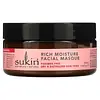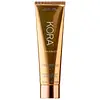What's inside
What's inside
 Key Ingredients
Key Ingredients

 Benefits
Benefits

 Concerns
Concerns

 Ingredients Side-by-side
Ingredients Side-by-side

Water
Skin ConditioningCetearyl Alcohol
EmollientGlyceryl Stearate
EmollientGlycerin
HumectantCoco-Caprylate
EmollientAloe Barbadensis Leaf Juice
Skin ConditioningRosa Canina Fruit Oil
EmollientTerminalia Ferdinandiana Fruit Extract
AntioxidantSantalum Acuminatum Fruit Extract
AntioxidantPunica Granatum Fruit Extract
AntioxidantCamellia Oleifera Seed Oil
Skin ConditioningTocopherol
AntioxidantCitrus Tangerina Peel Oil
MaskingCitrus Nobilis Peel Oil
MaskingLavandula Angustifolia Oil
MaskingVanillin
MaskingCetearyl Glucoside
EmulsifyingSodium Stearoyl Glutamate
CleansingLactic Acid
BufferingPhenoxyethanol
PreservativeBenzyl Alcohol
PerfumingLimonene
PerfumingLinalool
PerfumingWater, Cetearyl Alcohol, Glyceryl Stearate, Glycerin, Coco-Caprylate, Aloe Barbadensis Leaf Juice, Rosa Canina Fruit Oil, Terminalia Ferdinandiana Fruit Extract, Santalum Acuminatum Fruit Extract, Punica Granatum Fruit Extract, Camellia Oleifera Seed Oil, Tocopherol, Citrus Tangerina Peel Oil, Citrus Nobilis Peel Oil, Lavandula Angustifolia Oil, Vanillin, Cetearyl Glucoside, Sodium Stearoyl Glutamate, Lactic Acid, Phenoxyethanol, Benzyl Alcohol, Limonene, Linalool
Aloe Barbadensis Leaf Juice
Skin ConditioningPumice
AbrasiveGlycerin
HumectantRosa Canina Seed Powder
AbrasiveLactobacillus Ferment
Skin ConditioningWater
Skin ConditioningCamellia Sinensis Leaf Powder
ExfoliatingBambusa Arundinacea Stem Extract
Skin ConditioningOryza Sativa Extract
AbsorbentMorinda Citrifolia Seed Powder
Skin ConditioningLactobacillus
Skin ConditioningRosa Canina Fruit Oil
EmollientSodium Levulinate
Skin ConditioningSclerotium Gum
Emulsion StabilisingPopulus Tremuloides Bark Extract
AntiseborrhoeicCarica Papaya Fruit Extract
Skin ConditioningCetearyl Alcohol
EmollientSodium Anisate
AntimicrobialPotassium Sorbate
PreservativeCurcuma Longa Root Extract
MaskingCocos Nucifera Fruit Extract
EmollientSodium Stearoyl Glutamate
CleansingHelianthus Annuus Seed Wax
Skin ConditioningMentha Piperita Flower/Leaf/Stem Oil
Skin ConditioningLactic Acid
BufferingLavandula Angustifolia Oil
MaskingCitrus Limon Peel Oil
MaskingMaltodextrin
AbsorbentCetearyl Glucoside
EmulsifyingCarrageenan
Sodium Phytate
Cananga Odorata Flower Oil
MaskingJuniperus Virginiana Oil
MaskingGlucose
HumectantLeuconostoc Ferment Filtrate
AntimicrobialTocopherol
AntioxidantSoybean Peroxidase
AntioxidantSuperoxide Dismutase
AntioxidantAscorbyl Palmitate
AntioxidantAlcohol
AntimicrobialLimonene
PerfumingLinalool
PerfumingAloe Barbadensis Leaf Juice, Pumice, Glycerin, Rosa Canina Seed Powder, Lactobacillus Ferment, Water, Camellia Sinensis Leaf Powder, Bambusa Arundinacea Stem Extract, Oryza Sativa Extract, Morinda Citrifolia Seed Powder, Lactobacillus, Rosa Canina Fruit Oil, Sodium Levulinate, Sclerotium Gum, Populus Tremuloides Bark Extract, Carica Papaya Fruit Extract, Cetearyl Alcohol, Sodium Anisate, Potassium Sorbate, Curcuma Longa Root Extract, Cocos Nucifera Fruit Extract, Sodium Stearoyl Glutamate, Helianthus Annuus Seed Wax, Mentha Piperita Flower/Leaf/Stem Oil, Lactic Acid, Lavandula Angustifolia Oil, Citrus Limon Peel Oil, Maltodextrin, Cetearyl Glucoside, Carrageenan, Sodium Phytate, Cananga Odorata Flower Oil, Juniperus Virginiana Oil, Glucose, Leuconostoc Ferment Filtrate, Tocopherol, Soybean Peroxidase, Superoxide Dismutase, Ascorbyl Palmitate, Alcohol, Limonene, Linalool
Ingredients Explained
These ingredients are found in both products.
Ingredients higher up in an ingredient list are typically present in a larger amount.
Aloe Barbadensis Leaf Juice comes from leaves of the aloe plant. Aloe Barbadensis Leaf Juice is best known for helping to soothe sunburns. It is also anti-inflammatory, moisturizing, antiseptic, and can help heal wounds.
Aloe is packed with good stuff including Vitamins A, C, and E. These vitamins are antioxidants, which help fight free-radicals and the damage they may cause. Free-radicals are molecules that may damage your skin cells, such as pollution.
Aloe Barbadensis Leaf Juice also contains sugars. These sugars come in the form of monosaccharides and polysaccharides, folic acid, and choline. These sugars are able to help bind moisture to skin.
It also contains minerals such as calcium, 12 anthraquinones, fatty acids, amino acids, and Vitamin B12.
Learn more about Aloe Barbadensis Leaf JuiceCetearyl alcohol is a mixture of two fatty alcohols: cetyl alcohol and stearyl alcohol. It is mainly used as an emulsifier. Emulsifiers help prevent the separation of oils and products. Due to its composition, it can also be used to thicken a product or help create foam.
Cetearyl alcohol is an emollient. Emollients help soothe and hydrate the skin by trapping moisture.
Studies show Cetearyl alcohol is non-toxic and non-irritating. The FDA allows products labeled "alcohol-free" to have fatty alcohols.
This ingredient is usually derived from plant oils such as palm, vegetable, or coconut oils. There is debate on whether this ingredient will cause acne.
Due to the fatty acid base, this ingredient may not be Malassezia folliculitis safe.
Learn more about Cetearyl AlcoholCetearyl Glucoside is a surfactant and emulsifier. It can be produced from synthetic of natural sources of cetearyl alcohol and glucose.
Emulsifiers help prevent ingredients from separating, such as oils and waters. It can also be used to enhance the texture of products.
As a surfactant, Cetearyl Glucoside helps during the cleansing process. By gathering all the dirt and oils, it allows these molecules to be washed away easily.
Learn more about Cetearyl GlucosideGlycerin is already naturally found in your skin. It helps moisturize and protect your skin.
A study from 2016 found glycerin to be more effective as a humectant than AHAs and hyaluronic acid.
As a humectant, it helps the skin stay hydrated by pulling moisture to your skin. The low molecular weight of glycerin allows it to pull moisture into the deeper layers of your skin.
Hydrated skin improves your skin barrier; Your skin barrier helps protect against irritants and bacteria.
Glycerin has also been found to have antimicrobial and antiviral properties. Due to these properties, glycerin is often used in wound and burn treatments.
In cosmetics, glycerin is usually derived from plants such as soybean or palm. However, it can also be sourced from animals, such as tallow or animal fat.
This ingredient is organic, colorless, odorless, and non-toxic.
Glycerin is the name for this ingredient in American English. British English uses Glycerol/Glycerine.
Learn more about GlycerinLactic Acid is another well-loved alpha hydroxy acid (AHA). It is gentler than glycolic acid but still highly effective.
Its main role is to exfoliate the surface of the skin by loosening the “glue” that holds dead skin cells together. Shedding those old cells leads to smoother, softer, and more even-toned skin.
Because lactic acid molecules are larger than glycolic acid, they don’t penetrate as deeply. This means they’re less likely to sting or irritate, making it a great choice for beginners or those with sensitive skin.
Like glycolic acid, it can:
Lactic acid also acts as a humectant (like hyaluronic acid). It can draw water into the skin to improve hydration and also plays a role in the skin's natural moisturizing factor (NMF) in the form of sodium lactate.
Studies show it can boost ceramide production to strengthen the skin barrier and even help balance the skin’s microbiome.
To get results, choose products with a pH between 3-4.
Lower strengths (5-12%) focus on surface exfoliation; higher strengths (12% and up) can reach deeper in the dermis (deeper, supportive layer) to improve skin texture and firmness over time.
Though it was originally derived from milk, most modern lactic acid used in skincare is vegan. It is made through non-dairy fermentation to create a bio-identical and stable form suitable for all formulations.
When lactic acid shows up near the end of an ingredient list, it usually means the brand added just a tiny amount to adjust the product’s pH.
Legend has it that Cleopatra used to bathe in sour milk to help reduce wrinkles.
Lactic acid is truly a gentle multitasker: it exfoliates, hydrates, strengthens, and brightens. It's a great ingredient for giving your skin a smooth, glowing, and healthy look without the harshness of stronger acids.
Read more about some other popular AHA's here:
Learn more about Lactic AcidLavandula Angustifolia Oil is more commonly known as lavender essential oil. It is considered a fragrancing ingredient.
Lavender imparts a famous scent. While the smell is lovely, this ingredient and may sensitize skin in topical products. This is because about 85% of the oil is made up of linalool and linalyl acetate.
When exposed to air, these two compounds become strong allergens. This ingredient exhibits cytotoxicity at low concentrations; amounts of 0.25% have been shown to damage skin cells.
A study from Japan found this ingredient caused lavender sensitivity after widespread exposure.
Lavender essential oil has some antimicrobial, antibacterial, and anti-inflammatory properties. However, the cons of this ingredient may outweight the pros.
More research is needed to confirm lavender essential oil's effects when used in aromatherapy.
Lavandula Angustifolia is known as the English Lavender and famous for creating purple fields in Provence, France.
Learn more about Lavandula Angustifolia OilLimonene is a fragrance that adds scent and taste to a formulation.
It's found in the peel oil of citrus fruits and other plants such as lavender and eucalyptus. The scent of limonene is generally described as "sweet citrus".
Limonene acts as an antioxidant, meaning it helps neutralize free radicals.
When exposed to air, oxidized limonene may sensitize the skin. Because of this, limonene is often avoided by people with sensitive skin.
The term 'fragrance' is not regulated in many countries. In many cases, it is up to the brand to define this term. For instance, many brands choose to label themselves as "fragrance-free" because they are not using synthetic fragrances. However, their products may still contain ingredients such as essential oils that are considered a fragrance.
Learn more about LimoneneLinalool is a fragrance and helps add scent to products. It's derived from common plants such as cinnamon, mint, citrus, and lavender.
Like Limonene, this ingredient oxidizes when exposed to air. Oxidized linalool can cause allergies and skin sensitivity.
This ingredient has a scent that is floral, spicy tropical, and citrus-like.
Learn more about LinaloolRosehip Oil is a non-fragrant plant oil. Rosehips are a fruit from a rose bush and are edible. This oil has skin conditioning and hydrating properties.
Rosehip contains Vitamin C, Vitamin E, fatty acids and linolenic acids. These nourish your skin barrier. Having hydrated skin may help reduce the appearance of fine-lines and wrinkles.
Another great component of Rosehip Oil is Vitamin A, or retinol. Vitamin A encourages your skin to create more collagen.
Rosehip oil may help with reducing pigmentation. The lycopene and beta-carotene have skin-lightening properties. However, more studies are needed to confirm this.
Learn more about Rosa Canina Fruit OilSodium Stearoyl Glutamate is an emulsifier and helps condition the skin. It is amino acid-based.
In higher amounts, it may act as a cleansing agent.
Tocopherol (also known as Vitamin E) is a common antioxidant used to help protect the skin from free-radicals and strengthen the skin barrier. It's also fat soluble - this means our skin is great at absorbing it.
Vitamin E also helps keep your natural skin lipids healthy. Your lipid skin barrier naturally consists of lipids, ceramides, and fatty acids. Vitamin E offers extra protection for your skin’s lipid barrier, keeping your skin healthy and nourished.
Another benefit is a bit of UV protection. Vitamin E helps reduce the damage caused by UVB rays. (It should not replace your sunscreen). Combining it with Vitamin C can decrease sunburned cells and hyperpigmentation after UV exposure.
You might have noticed Vitamin E + C often paired together. This is because it is great at stabilizing Vitamin C. Using the two together helps increase the effectiveness of both ingredients.
There are often claims that Vitamin E can reduce/prevent scarring, but these claims haven't been confirmed by scientific research.
Learn more about TocopherolWater. It's the most common cosmetic ingredient of all. You'll usually see it at the top of ingredient lists, meaning that it makes up the largest part of the product.
So why is it so popular? Water most often acts as a solvent - this means that it helps dissolve other ingredients into the formulation.
You'll also recognize water as that liquid we all need to stay alive. If you see this, drink a glass of water. Stay hydrated!
Learn more about Water